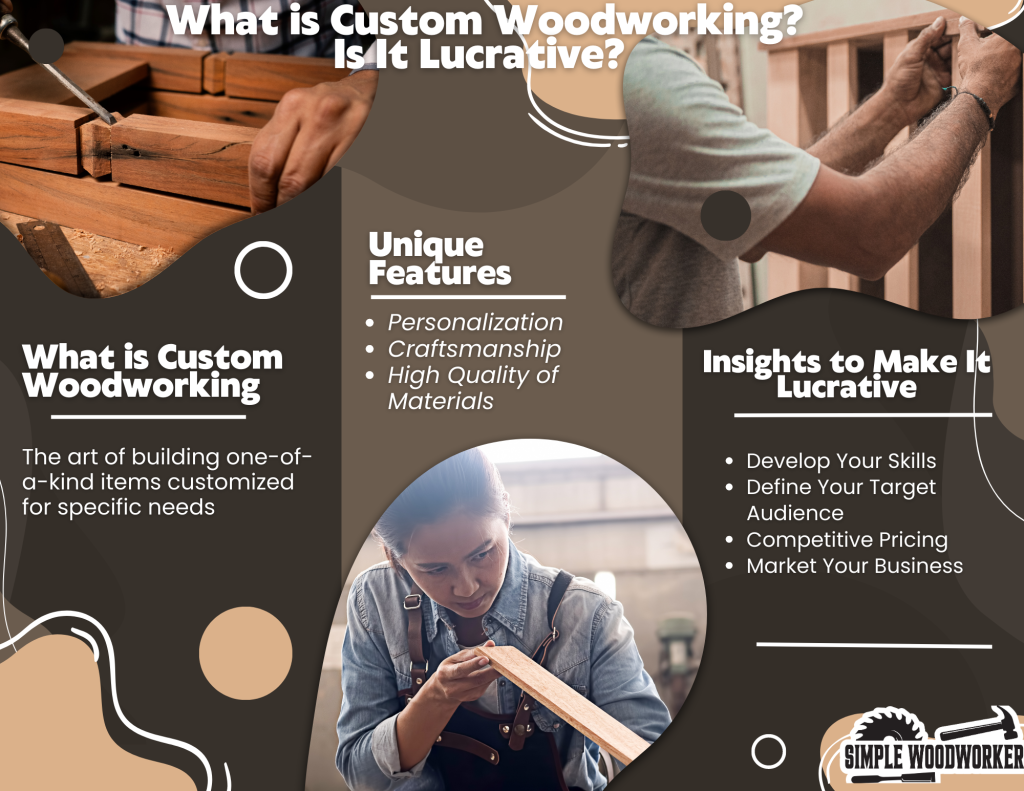Welcome to our guide on custom woodworking. Where we delve into the world of personalized woodwork. Read on to learn everything you need to know about custom woodworking as an art and a business.
What is Custom Woodworking?
Custom woodworking is the art of building one-of-a-kind items customized for specific needs. Unlike mass production, custom woodwork focuses on unique and client-specific needs. A custom woodworker is like your personal tailor. There are lots of clothes at the boutique, but sometimes you want something unique. So your tailor makes your clothes with your measurements and style requirements. A custom woodworker collaborates with clients in a similar way. The client has complete control over the design of the produced item.
Skill Level and Process In Custom Woodworking
Custom woodwork is often done by a woodwork artisan. It requires a very high level of craftsmanship and deep knowledge of wood properties. The custom woodworker must have excellent attention to detail. He must also be artistic enough to create blueprints and designs from a client’s verbal description. This involves scales, special patterns, and color schemes. For woodworking beginners, this might sound demanding but worry not. Every artisan was once a novice.
The process of making custom woodwork is different from the mass-produced ones. As we said, it’s like buying clothes from a personal tailor. Through open dialogue, the custom woodworker tries to understand the client’s preferences. This serves as the project’s foundation.
Once the client’s vision is clear, the woodworker turns it into design plans and blueprints. This involves consideration of dimensions, wood type, and construction technique. Once an action plan is clear, the woodworker uses various hand tools and techniques to make the item. The final stage involves adding the finishing touches like color and wood oil.

Custom Woodwork VS Mass-Produced Woodwork
We’ve already established that custom woodwork differs from mass production. But let’s delve deeper into what separates a customized product from those at the furniture shop:
Personalization
Let’s start off with the biggest distinction between them. Custom woodwork focuses on creating unique pieces tailored to a client’s preferences. In contrast, mass-produced pieces are made in large quantities with a standard design. The result is identical pieces, while customized woodwork is one-of-a-kind.
Craftsmanship
Custom woodworking emphasizes high-level skill and attention to detail. They dedicate time and meticulous planning to each piece. Mass production has other priorities like efficiency and cost-effectiveness. The manufacturing process involves standard measurements and techniques, resulting in a uniform appearance.
Quality of Materials
Custom woodcraft prioritizes the use of high-quality materials. This is to increase the sustainability of the project and to enhance the final result. Mass-produced woodwork uses more cost-effective materials that are sourced in large quantities. While they are suitable, they don’t match the quality of custom woodwork materials.

Is Custom Woodworking Lucrative
This brings us to the fourth difference between custom woodwork and mass-produced woodwork: PRICE.
Custom pieces are more valuable than mass-produced woodwork. This is the first thing you need to know about turning custom woodworking into a business. Why? Well, the answer is simple. Custom woodwork is done one at a time, with hand techniques, and requires high skill and time. While mass-produced woodwork is all pre-made with set specifications. Hence, the quality and personalization of custom woodwork can’t be found at a furniture store.
Now why is this important?
The major hindrance to a lucrative custom woodwork business is its high price. There are other business challenges in custom woodwork (more on that soon). But mass-produced woodwork being cheaper and accessible to consumers is the primary issue. There is a market for personalized and handcrafted woodwork, but it’s limited. Most people would rather buy regular furniture from the local store. This bias toward mass-produced items means your business conditions need to be perfect. This is the only way for customers to ignore the price differential.
Market competition isn’t the only concern with custom woodworking as a business. The whole process of making custom woodwork is quite challenging. For starters, projects can be time-consuming. The detail and precision required often lead to longer production times. Also, juggling multiple clients while meeting production standards and deadlines can be demanding.
You may also face financing problems as custom woodworking requires substantial capital. Sourcing quality wood in areas where they aren’t available might cost a lot in importation. There’s also continuous skill development and staying updated with new techniques. These cost time and money.
In summary, building a successful custom woodwork business is a tough ask in the current market. But don’t worry; it’s not all doom and gloom….
How To Make Your Custom Woodworking Lucrative
Despite the challenges, many have built successful businesses from this craft. But as we said, it requires perfect skill and business conditions. Here are some steps you can take to help you establish and grow your custom woodwork business:
Develop Your Skills
Constant skill development by practicing and learning new techniques is important. Clients will ignore the price difference if your work is high-quality. You need to provide them with better value for money than factory-produced pieces.
Define Your Target Audience
It’s important to identify your selling points and determine your market expertise. This will help you tailor your marketing efforts toward attracting the right customer. You could specialize in woodwork cabinets, indoor furniture pieces, home décor items, custom CNC wood, etc.
Competitive Pricing
Set competitive and profitable pricing for your custom woodworking projects. Consider factors such as material costs, labor, overhead expenses, and desired profit margins. Review and track your finances to track your business’s financial sustainability.
Market Your Business
Implement effective marketing strategies to increase your visibility and attract clients. Utilize, SEO, online advertising, and traditional advertising methods to reach your target audience.
Conclusion
That’s it for our guide on custom woodworking. While it has its challenges, by combining woodworking expertise and proper marketing, you can build a lucrative business from custom woodcraft. Ensure your services are high-quality, cultivate strong client rapport and maintain competitive prices. Good luck!`
*This post may contain affiliate links. Please see my disclosure to learn more.



